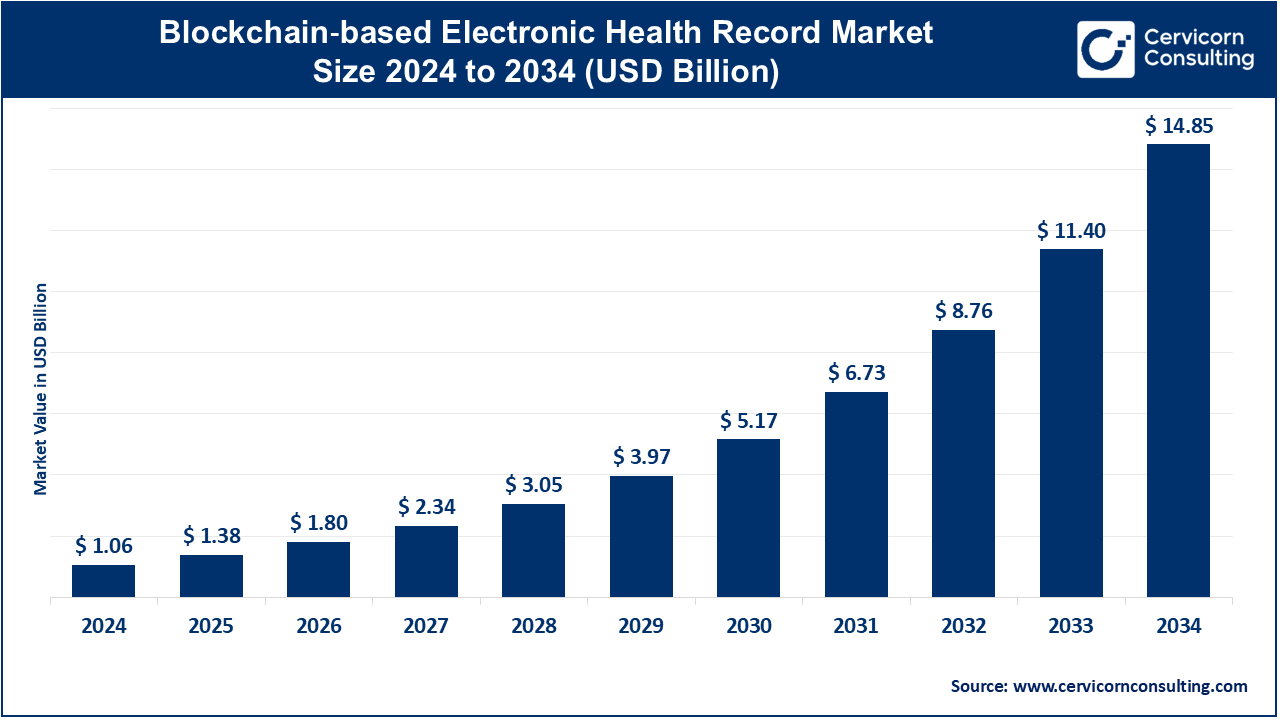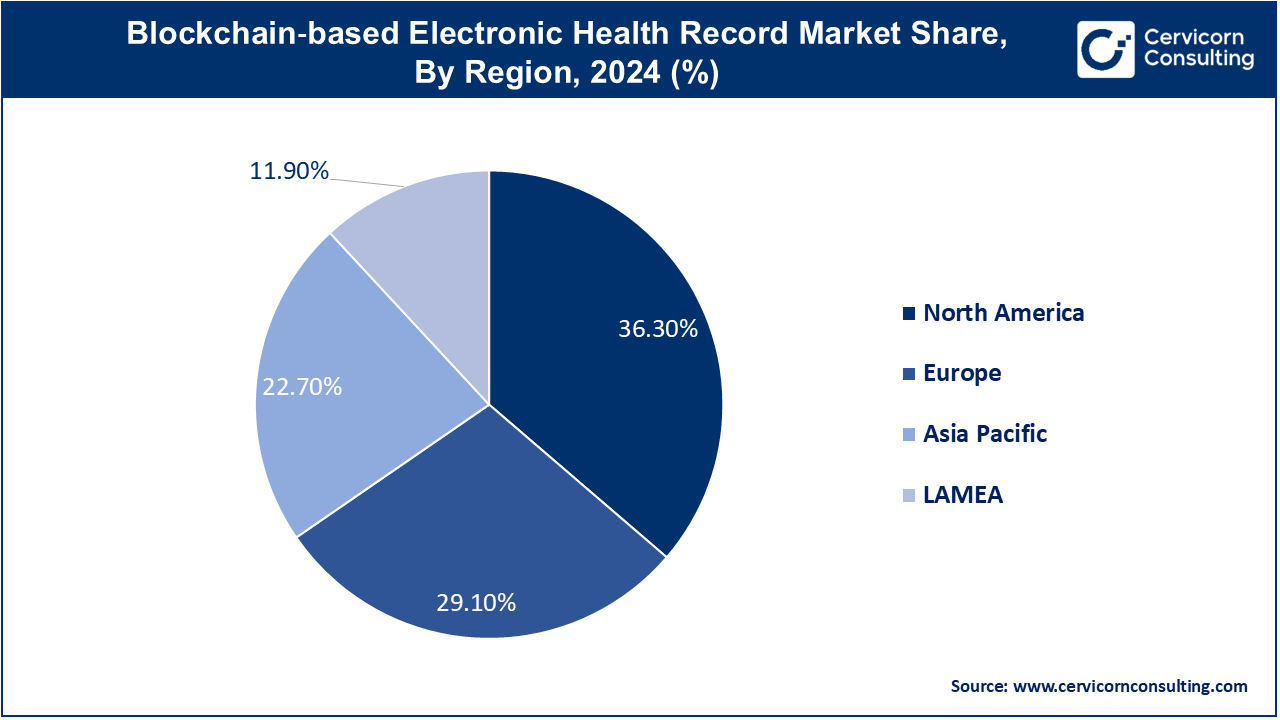The global blockchain-based electronic health record market size was valued at USD 1.06 billion in 2024 and is expected to be worth around USD 14.85 billion by 2034, exhibiting at a compound annual growth rate (CAGR) of 30.2% over the forecast period 2025 to 2034.

The growth of the blockchain-based electronic health record (EHR) market is being driven by the increasing need for secure, interoperable, and patient-centric healthcare systems. Conventionally, EHR systems are hindered by inefficiencies such as data fragmentation, delayed updates, and security breaches. Blockchain technology aims to resolve these issues by providing immutable and decentralized data storage, facilitating trusted and transparent data sharing among stakeholders. The surge in cyberattacks on healthcare facilities, along with regulatory demands for data security and interoperability (e.g., HIPAA, GDPR), has made blockchain a highly desirable solution. Furthermore, the increased uptake of telemedicine and digital health solutions following COVID-19 has further driven demand for secure data exchange mechanisms.
One recent example of this trend is IBM's partnership with Abu Dhabi-based health tech company, Mubadala Health, in early 2024. The alliance aims to create a blockchain-based platform for securely managing patient records across multiple facilities in the UAE, ensuring data consistency and real-time updates while keeping patient information private. This example illustrates how governments and private sectors are increasingly investing in blockchain for healthcare to enhance data security and interoperability at scale.
What is a Blockchain-based Electronic Health Record?
A blockchain-based electronic health record (EHR) is a computerized patient health record system that utilizes blockchain technology for the secure storage, management, and exchange of medical information. Unlike traditional EHRs, which rely on centralized databases, blockchain-based EHRs use a decentralized ledger where each transaction or modification is recorded as a block, dated chronologically, and protected through cryptography. This ensures data immutability, transparency, and security, making it very difficult to manipulate or alter patient information without detection. All stakeholders—whether they are a physician, patient, insurer, or researcher—can access consistent, real-time data with appropriate authorization, fostering collaboration and informed decision-making.
Blockchain-based EHRs have various applications, including managing patient data, tracking medical histories, secure sharing among providers, clinical trials, and processing insurance claims. These systems facilitate interoperability among diverse healthcare providers and empower patients with greater control over their health information, allowing them to grant or revoke access as needed. Such systems are particularly beneficial in enhancing healthcare delivery, reducing administrative errors, and preventing data breaches. As the healthcare sector embraces digital transformation and value-based care, blockchain-based EHRs offer a scalable and secure platform for next-generation health IT systems.
Rising Adoption in National Health Systems
Governments and health authorities are increasingly interested in blockchain for large-scale EHR integration to promote secure, uniform access to patients' information.
Patient-Centric Health Data Ownership
Blockchain is enabling the transition to models where patients gain greater control over their medical records, including the rights to grant and withdraw access.
Integration with IoT and Wearable Devices
Blockchain is utilized to securely record health data produced by IoT medical devices and wearables, guaranteeing its authenticity and privacy.
Use in Medical Research and Clinical Trials
Blockchain allows researchers to access anonymized health information for research purposes while maintaining patient confidentiality and consent.
Strategic Collaborations Across Industries
Tech giants, hospitals, and insurance companies are forming alliances to build blockchain ecosystems for interoperable health data.
| Area of Focus | Details |
| Market Size in 2025 | USD 1.38 Billion |
| Expected Market Size in 2034 | USD 14.85 Billion |
| Projected CAGR from 2025 to 2034 | 30.20% |
| Dominant Area | North America |
| Fastest Growing Region | Asia Pacific |
| Key Segments | Components, Blockchain Types, Deployment Modes, End Users, Region |
| Key Companies | Medicalchain, Patientory, BurstIQ, Guardtime, IBM Corporation, Change Healthcare, Hashed Health, Factom, Solve.Care, Healthereum, Chronicled, Doc.ai |
The blockchain based electronic health record market is segmented into components, blockchain types, deployment modes, end users, and regions. Based on components, the market is classified into software, hardware, and services. Based on the blockchain types, the market is classified into private blockchain, public blockchain, consortium blockchain, and others. Based on deployment modes, the market is classified into on-premise, cloud-based, and hybrid deployment. Based on end user, the market is classified into hospitals and clinics, research institutions, insurance providers, pharmaceutical companies, and patients.
The software segment is the dominant component in the blockchain-based EHR market. Software offerings form the bedrock of the flow of electronic health records and ensure secure data storage and sharing. Software is indispensable for clinics and hospitals since it automates workflows, prevents compliance issues, and enhances outcomes. The sustained need for flexible and scalable EHR solutions that incorporate blockchain for increased security and interoperability has cemented the leadership of this segment. As healthcare systems increasingly deploy blockchain for secure data transfer, the software segment is likely to maintain its leadership in the near future.
The services segment is the fastest-growing component. As blockchain technology is complicated, most healthcare organizations outsource consulting, integration, and management to external experts. Since hospitals and clinics want to adopt blockchain-based systems without any hassles, the demand for specialist services is increasing rapidly. Support, training, and post-deployment service firms are driving the adoption of blockchain by providing services and are thus expected to further fuel this segment over the next few years.
The private blockchain segment is the dominant type in the blockchain-based EHR market. Its centralized control structure enables healthcare organizations to manage access to patient information while maintaining security, which is critical for sensitive health information. Private blockchains also facilitate quicker transaction processing, which is essential in clinical environments. With the increasing demand for data privacy and adherence to healthcare regulations, private blockchains remain the preferred option for hospitals, insurance companies, and government health organizations.
The consortium blockchain segment is the fastest-growing type of blockchain. In this model, a collective is shared in which multiple entities, such as hospitals, insurance providers, and research institutions, collaborate while controlling the network. Consortium blockchains are increasingly sought after because they are more scalable and transparent, yet still provide centralized control. Therefore, they are well-suited for large-scale multi-stakeholder networks within the healthcare sector. As more organizations seek collaborative data-sharing models, the consortium blockchain segment is expected to experience significant growth.
The on-premise deployment model remains the dominant choice in the blockchain-based EHR market. Healthcare organizations, especially large hospitals, favor on-premise systems to retain complete control over sensitive patient information. This model addresses data sovereignty and security issues, which are critical in the highly regulated healthcare sector. Hospitals and clinics with existing IT infrastructure continue to prefer on-premise systems for their blockchain-based health records.
The cloud-based deployment model is the fastest-growing in the market. Cloud-based solutions provide healthcare organizations with flexibility, scalability, and lower capital expenditures compared to on-premise systems. As the healthcare industry increasingly embraces digital transformation, cloud-based blockchain solutions are becoming the preferred option for smaller clinics, telehealth providers, and emerging markets. Ease of integration with current digital health platforms and scalability as needed are the major factors driving the growth of this segment.
Hospitals and clinics represent the dominant end-user group in the blockchain-based EHR market. These institutions generate and manage vast amounts of patient data, making the need for secure, interoperable systems crucial. Blockchain-based EHR systems provide hospitals and clinics with a cost-effective and secure method for electronic record management, improving patient care coordination and lowering administrative costs. The growing use of blockchain technology among these organizations will continue to keep this segment dominant in the market.
The patient segment is the fastest-growing in the blockchain-based EHR market. As healthcare data gains wider awareness and the demand for personal control increases, patients are turning to blockchain solutions for securely storing and sharing their health records. This trend is driven by the rising utilization of digital health tools, patient portals, and mobile apps that leverage blockchain for data security and privacy. With more patients asking for transparency and control over their health information, this sector is expected to witness rapid growth.
The blockchain based electronic health record market is segmented into various regions, including North America, Europe, Asia-Pacific, and LAMEA.
The North America blockchain based electronic health record market size was reached at USD 0.38 billion in 2024 and is expected to reach around USD 5.39 billion by 2034, driven by the robust healthcare infrastructure in the U.S. and Canada. North America's early adoption of blockchain technology in healthcare, along with stringent regulatory frameworks like HIPAA, has fueled the implementation of blockchain-based EHR systems. Healthcare professionals in North America have a strong desire to enhance data security, interoperability, and patient privacy, resulting in high demand for blockchain solutions. The region is also supported by leading players, research centers, and technology companies, which continually drive innovation and growth within the market.

The Asia-Pacific blockchain based electronic health record market size was estimated at USD 0.31 billion in 2024 and is expected to hit around USD 4.32 billion by 2034, primarily driven by the increasing adoption of digital health technologies, growing healthcare expenditures, and rising government efforts to improve healthcare access. China, India, and Japan are making substantial investments in blockchain to enhance the efficiency and security of medical data management. With extensive populations and fragmented healthcare infrastructures, APAC nations are seeking decentralized platforms like blockchain to improve data sharing and cooperation among healthcare providers. The increasing digitalization of the region, particularly in emerging economies, positions it as a high-growth potential market for blockchain-based EHR adoption.
The Europe blockchain based electronic health record market size was accounted for USD 0.24 billion in 2024 and is projected to reach around USD 3.37 billion by 2034. Europe is also witnessing notable growth, with countries like Germany, the UK, and France leading the charge. The European Union's focus on data privacy through legislation such as GDPR is a primary motivator for the adoption of blockchain in healthcare. Several European nations are considering blockchain for secure data exchange, patient consent management, and improving cross-border healthcare interoperability. Furthermore, the region's established healthcare systems are increasingly implementing innovative solutions to tackle issues like data fragmentation and inefficiency. As healthcare providers seek to meet regulatory requirements and enhance patient care, blockchain-based EHR solutions are emerging as a top choice for the region.

The LAMEA blockchain based electronic health record market was valued at USD 0.13 billion in 2024 and is anticipated to surpass around USD 1.77 billion by 2034. The LAMEA region is still in the early stages of adopting blockchain-based EHR systems but is expected to grow with increasing healthcare investments and government initiatives. Brazil and South Africa are starting to explore blockchain for managing healthcare data and improving access to medical records. In the Middle East, countries such as the UAE and Saudi Arabia are aggressively pursuing digital health strategies, including blockchain, to transform their healthcare infrastructure. While the region faces challenges like infrastructure deficits and varying levels of digital literacy, the rising demand for health data security, transparency, and empowered patients presents significant opportunities for blockchain-based EHR strategies in the coming years.
The blockchain-based EHR market is highly competitive, with both major tech firms and startups aiming to transform health data through blockchain technology. IBM Corporation and Change Healthcare leverage their capabilities to provide secure, interoperable systems across extensive medical networks. Startups such as Medicalchain, Patientory, BurstIQ, and Guardtime specialize in patient-oriented platforms and secure data sharing. Hashed Health, Factom, and Solve.Care form alliances to deliver blockchain solutions for claims processing and care coordination. This rapidly evolving market thrives on funding, partnerships, and innovation, with companies competing to establish early dominance in digital health.
Market Segmentation
By Component
By Blockchain Type
By Deployment Mode
By End-User
By Region